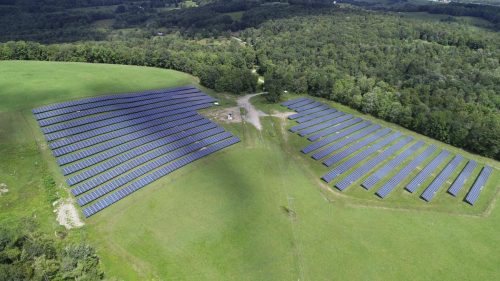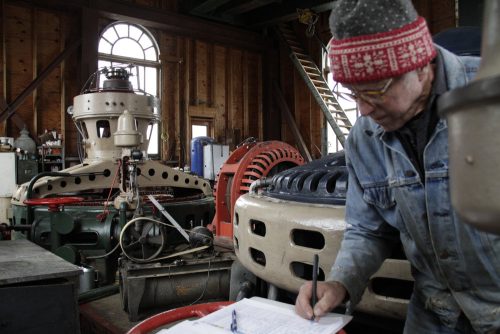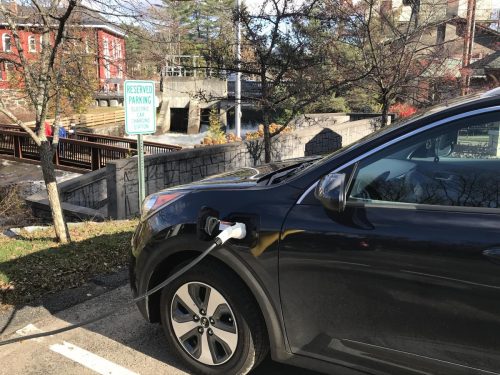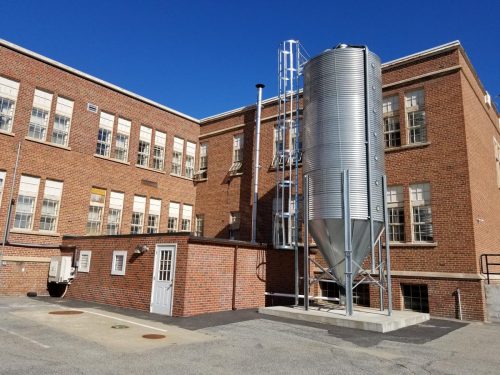Part 2
In my last blog, I shared my reflections about the value of localizing our energy choices. I contrasted the dominant centralized grid — which imports most of its energy across millions of years and thousands of miles in the form of coal, oil, natural gas and nuclear energy and the damaging impacts that consumption of these fuels has on human health — with the more resilient, locally sourced distributed grid of the future. 
As New York State rolls out the recently adopted Climate Leadership and Community Protection Act (CLCPA), pressure to rapidly increase the amount of renewable energy generated and to reduce the amount of carbon producing fuel sources will be immense. While ANCA supports this effort wholeheartedly, we join our colleagues and neighbors in stressing that the impacts of all decisions should take into account the communities within which new systems will be located.
We believe we can have our proverbial cake and eat it too — maximizing benefits for people and planet alike — but only if we proceed mindfully.
We are entering a new era as we gradually transition away from a consumptive, commodity economy to one that values intangible factors and values. Nowhere is this more true than in the transitioning energy economy such as through ecosystem services, grid reliability, fluctuating demand, and benefits to local communities. I invite you to imagine energy as more than the movement of electrons or units of heat — but as the full balance of where it comes from and how it gets to your building. This might include restoration and maintenance of local hydro facilities and their impoundments, local job creation, and maximizing community benefits from large-scale renewable projects.
I propose that locally sited energy allows for full recognition of the impacts (including negative ones) of our energy choices. Not in my backyard (NIMBY) is a real and genuine consideration, however, to be good citizens of this planet and to make truly informed decisions, both positive and negative impacts of our energy choices should be readily apparent.
Energy regulatory frameworks are in constant flux as policy makers blaze their way through uncharted territory. This makes it difficult to establish the market certainty that businesses depend upon. Vision, adaptiveness and out-of-the-box thinking have opened doors to multiple opportunities for securing locally generated energy, despite these uncertainties.
If you’re on board with the clean energy transition, but don’t know how to get started, below are a variety of options for your consideration.
More detailed information and regional resources can be found on our local energy resources page.
“NEGAWATTS:”
Energy efficiency guru Amory Lovins coined the term “negawatt” which means that on balance, every watt of energy that you don’t consume is a watt of energy saved. Before considering renewable heating opportunities, be sure to get an energy audit done to identify opportunities to tighten and insulate your buildings.
ELECTRICITY: 
Community Distributed Generation (CDG) was enabled in this state in 2015. It permits a developer to offer a portion of remotely sited electrical generation (typically solar, but increasingly small hydro) to multiple “off-takers” through subscription or purchase of a share. Under current regulations, these off-takers need to be located in the same utility as the project (National Grid or NYSEG). A typical agreement involves no commitment contracts (you can withdraw with no penalty), reductions on your current bill and minimal requirements for participation. You may have seen advertisements from companies asking you to sign up.
Energy Services Companies (ESCOs) provide electricity supply options that can reduce electric bills or offer green alternatives, but some companies have taken advantage of loopholes resulting in deceptively escalating payments. Our energy circuit rider team has helped multiple municipalities identify unfair ESCO practices, savings thousands of taxpayer dollars a year. The Public Service Commission is committed to addressing this issue; you can stage a formal complaint through their online complaint page. Despite a handful of bad actors, there are reputable options that will save you money and allow you to have a say about where your electricity comes from.
Renewable Community Choice Aggregation (CCA) is in the early stages of development in the North Country. CCAs provide opportunities for a municipality to procure electricity on behalf of all residents within their boundaries. Residents would be offered an opt out option if they do not want to participate, but ideally the source would offer lower and more stable pricing from a cleaner, locally generated source of electricity. “Brown” CCAs are also available, supplied from sources that are not renewable.
Power Purchase Agreements (PPA) involve a contractual relationship between a larger consumer of electricity (university, municipalities, etc.) and a supplier such as hydro or solar companies. This arrangement typically involves an investor who owns the generating system and takes advantage of tax credits, selling the power to the off-taker over an agreed upon time frame. At this point in time, current regulations typically make new PPA’s untenable. This agreement has been referred to as remote net metering.
Onsite renewables, such as rooftop or ground mount solar, small wind and increasingly stored energy, remain popular options. State and federal tax credits and state level incentives to install solar at your home or place of business are still available. These incentives only apply if you are “grid-tied” meaning that your renewable electrons flow into the grid when you are generating power and you draw from the grid when you are not. The amount that you generate versus the amount that you consume is balanced out over the course of a year, which is reflected in your utility bill. Some in the North Country have opted for being “off-grid,” using batteries and generators. Still others have installed a hybrid system that provides the benefit of onsite energy backup in the event that their grid-connection is disrupted.
If you are interested in onsite, the best next step is to speak with someone who has installed onsite renewables or to reach out to your local installers.
“Green” power can often be purchased through utilities upon request, sometimes with a slight increase in the supply line of your utility bill. Contact your local utility to see if this works for you.
Municipal electric: If you are fortunate to live within one of the six municipal electric communities in the region, you are already supporting local power! This unique partnership with NYPA provides communities access to cheap power (typically hydro) resulting in very low rates. Contact your local municipal electric department to learn about energy related incentives and programs.
TRANSPORTATION: 
Electric vehicles (EV/PHEV*): The next time you are standing at the gas station filling your tank, consider the millions of years and thousands of miles that each of those gallons of fuel have taken to flow out of the nozzle and into your tank. Energy dense fossil fuels have been an integral part of modern civilization, and we thank them for their service. But their use has come at great cost to individual and planetary health. The time has come to evolve and move on. As the electrical grid becomes increasingly renewable (it is already 94% renewable in the North Country), the push to electrify our heating and transportation systems is on. NYSERDA currently offers incentives which, when added to federal tax credits, make owning an EV or plug-in hybrid (PHEV*) affordable. “Range anxiety” is rapidly vanishing with new EV charging stations popping up across the region.
*Plug in hybrid electric vehicles include options for electric and combustion within the same system.
THERMAL (HEAT):
Biomass: A quick drive through the North Country this time of the year will lead you by dozens of houses with stacked (or if you’re at my home — waiting to be stacked) piles of wood. The region is rich in its history with timber resources, and the timber industry currently accounts for millions of dollars of revenue and regional benefit. Whether you stoke your woodstove, fill a hopper on a pellet stove, or opt for an automated high efficiency pellet boiler, using biomass rather than imported fuel oil, propane, natural gas or kerosene provides a low net carbon investment in your community. Regionally harvested and processed pellets can be delivered to your home in a bulk delivery truck, or picked up at local stores by the bag or pallet.
Heat pump options are rapidly growing with improvements in technology and support from the State and utilities. Just as your refrigerator keeps your meats and milk cold, heat pumps work on the same concept — just in reverse. Whether extracting heat from ground water (ground source) or the air (air source), options to heat an entire building or space conditioning are increasingly affordable and efficient. Heat pump hot water heaters are also gaining in popularity. Contact your local HVAC contractor to learn more. There are also incentives available through National Grid and NYSERDA.
Solar thermal technology takes advantage of solar energy to pre-heat domestic water. Most consumers will need to boost water temperature with a secondary heat source to reach optimal temperatures, however the amount of energy needed to reach these temperatures will be lower as water enters the system much warmer than without the added boost from the sun. Glycol mixed with the heating medium prevents freezing during the cold North Country winter months.
Passive Solar Design is something every new building should consider. Designing a home with abundant south-facing windows and minimal north-facing extrusions can lead to a building, when well insulated and sealed, that eliminates up to 95% of its typical mechanical needs for heating, lighting and cooling! Consult with your local contractor or architect to discuss options to take advantage of all that free heat and ventilation.
The opportunity for diversification and customization lies at the core of locally available energy. As with the whales in my previous blog, choices allow us the ability to turn inward and assess what you want your community to look and feel like.
By localizing our energy, we grow our local economies and build resilience and sustainability in our communities. Contact ANCA’s Clean Energy Program today to learn more about how you can localize your energy options.
Clean Energy Program
(518) 891-6200
[email protected]
More detailed information and regional resources can be found on our local energy resources page.
Banner photo: Hydroelectric facilities are an integral piece of the culture for North Country villages like St. Regis Falls. Photo of Azure Mountain Power facility by Aaron Hobson.
Photo 1: Mooers Forks community solar arrays. Photo courtesy of Delaware River Solar.
Photo 2: Azure Mountain Power owner/operator Everitt Smith records data at their hydro facility in St. Regis Falls, NY. Photo by Aaron Hobson.
Photo 3: EV car plugged in behind Saranac Lake hydroelectric facility. Electric vehicles with locally available electrons offer regional options to offset fossil fuels from thousands of miles and millions of years away. Photo by Jen Perry.
Photo 4: A wood pellet silo stands tall outside Chestertown Municipal Building. Wood pellets power the building’s steam boiler.
Photo 5: Thermal imaging camera. Red and orange show valuable heat leaking out of a home. Trained professionals can identify opportunities to keep the heat in your home and more dollars in your wallet.
